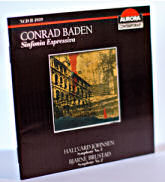| Discography: |
 Buy this CD here |
Symphony no 13, opus 90
String quartet no 4, opus 106 Wind quintet no 3, opus 98 |
 Buy this CD here |
Symphony no 3, «In memoriam», opus 26 Completed in 1957, Symphony no 3 was premiered by The Danish Radio Symphonic Orchestra in 1959 under the leadership of Thomas Jensen. This symphony marked a distinct departure in Hallvard Johnsen’s stylistic development. He moved on from his new-national romantic period to the free-tonal style. But even though Johnsen felt attracted to the atonal musical language, he preferred working on both sides of this borderline. The symphony was entitled «In Memoriam»: He wanted to honour his parents Alma and Sverre Johnsen and dedicated the symphony to their memory. The idea and basic sketch of the work appeared during a sailing trip with his oldest brother Thorvald. The forces of nature took hold of the boat, large waves suddenly arose and the brothers had to seek refuge at Jeløya. During the night Hallvard thought he could hear three tones being repeated out on the storm-swept sea. He wrote down the tones and later showed them to his teacher Bjarne Brustad. However, his teacher advised him to let this idea wait; he thought Johnsen was still too young. Twenty years later the three tones were made into the main theme of his third Symphony. The dramatic experience of nature’s capricious forces was the inspiration for the theme of «In Memoriam». In this symphony Hallvard Johnsen displays his complete mastery of the technical craft of composing. However, he stated that he put no emphasis on the technical aspect itself. As he put it: «I never write a note without having felt it first.» The symphony consists of a single movement.
After the premiere his teacher at the Conservatoire in Copenhagen, Professor Vang Holmboe, said to the newspapers: «Hallvard Johnsen’s symphony no 3, opus 26, is unmistakably and consistently the work of a true musician. It is composed by a man who has something to tell us, and who is able to do so in a technically justifiable and musically persuasive way. The thematic substance and the development of the musical motifs are full of character in both impulse and execution. The entire composition is well organized and beautifully rounded off.
|
